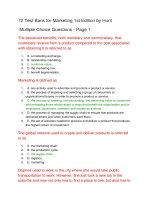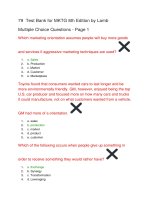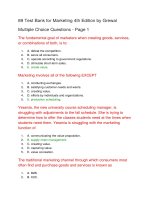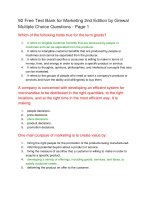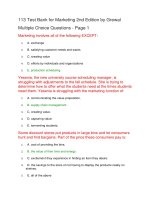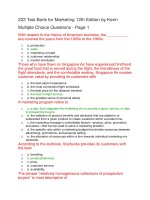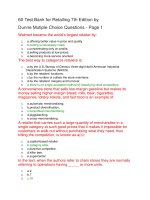Test bank for computing essentials 2011 making IT work for you 21st edition by OLeary
Bạn đang xem bản rút gọn của tài liệu. Xem và tải ngay bản đầy đủ của tài liệu tại đây (140.74 KB, 43 trang )
Full file at />
Chapter 01
Globalization
True / False Questions
1. (p. 7) Globalization refers to the shift toward a more integrated and interdependent world
economy.
TRUE
AACSB: Analytic
BT: Knowledge
Difficulty: Easy
Learning Objective: 1-1
Topic: What Is Globalization?
2. (p. 7) Tastes and preferences of consumers in different nations are beginning to converge on
some global norm.
TRUE
AACSB: Analytic
BT: Knowledge
Difficulty: Easy
Learning Objective: 1-1
Topic: What Is Globalization?
3. (p. 7) A company has to be a major multinational corporation to facilitate, and benefit from,
the globalization of markets.
FALSE
AACSB: Analytic
BT: Knowledge
Difficulty: Medium
Learning Objective: 1-1
Topic: What Is Globalization?
buy this full document at
Full file at />
4. (p. 7) In Germany, 98 percent of small and midsize companies have exposure to international
markets.
TRUE
AACSB: Analytic
BT: Knowledge
Difficulty: Easy
Learning Objective: 1-1
Topic: What Is Globalization?
5. (p. 8) Currently, the most global of markets are for industrial goods and materials that serve a
universal need the world over.
TRUE
AACSB: Analytic
BT: Knowledge
Difficulty: Easy
Learning Objective: 1-1
Topic: What Is Globalization?
6. (p. 8) As firms follow each other around the world, greater diversity replaces uniformity.
FALSE
AACSB: Analytic
BT: Knowledge
Difficulty: Easy
Learning Objective: 1-1
Topic: What Is Globalization?
7. (p. 10) Substantial impediments such as barriers to foreign direct investment make it difficult
for firms to achieve the optimal dispersion of their productive activities to locations around
the globe.
TRUE
AACSB: Analytic
BT: Knowledge
Difficulty: Easy
Learning Objective: 1-1
Topic: What Is Globalization?
buy this full document at
Full file at />
8. (p. 10) GATT stands for the General Agreement on Tariffs and Trade.
TRUE
AACSB: Analytic
BT: Knowledge
Difficulty: Easy
Learning Objective: 1-1
Topic: The Emergence of Global Institutions
9. (p. 10) As of 2008, 149 nations, which collectively accounted for 90 percent of world trade,
were WTO members.
FALSE
AACSB: Analytic
BT: Knowledge
Difficulty: Easy
Learning Objective: 1-1
Topic: The Emergence of Global Institutions
10. (p. 11) The United Nations and the World Bank were both created in 1944 by 44 nations that
met at Breton Woods, New Hampshire.
FALSE
AACSB: Analytic
BT: Knowledge
Difficulty: Easy
Learning Objective: 1-1
Topic: The Emergence of Global Institutions
11. (p. 11) The IMF is often seen as the lender of last resort to nation-states whose economies
are in turmoil.
TRUE
AACSB: Analytic
BT: Knowledge
Difficulty: Easy
Learning Objective: 1-1
Topic: The Emergence of Global Institutions
buy this full document at
Full file at />
12. (p. 12) After World War I, the advanced nations of the West committed themselves to
removing barriers to the free flow of goods, services, and capital between nations.
FALSE
AACSB: Analytic
BT: Knowledge
Difficulty: Easy
Learning Objective: 1-2
Topic: Drivers of Globalization
13. (p. 12) In addition to reducing trade barriers, many countries have also been progressively
removing restrictions to foreign direct investment.
TRUE
AACSB: Analytic
BT: Knowledge
Difficulty: Easy
Learning Objective: 1-2
Topic: Drivers of Globalization
14. (p. 13) Since the mid-1980s, the value of international trade in services has been decreasing
compared to trade in production.
FALSE
AACSB: Analytic
BT: Knowledge
Difficulty: Easy
Learning Objective: 1-2
Topic: Drivers of Globalization
15. (p. 13) The volume of world output has grown faster than the volume of world merchandise
trade since the 1950s, according to data from the World Trade Organization.
FALSE
AACSB: Analytic
BT: Knowledge
Difficulty: Medium
Learning Objective: 1-2
Topic: Drivers of Globalization
buy this full document at
Full file at />
16. (p. 14-15) Moore's Law predicts that the power of microprocessor technology doubles and its
cost of production declines in half every 18 months.
TRUE
AACSB: Analytic
BT: Knowledge
Difficulty: Easy
Learning Objective: 1-2
Topic: Drivers of Globalization
17. (p. 15) By 2007, the Internet had more than 3 billion users, or about 25% of the world's
population.
FALSE
AACSB: Analytic
BT: Knowledge
Difficulty: Easy
Learning Objective: 1-2
Topic: Drivers of Globalization
18. (p. 16) As transportation costs associated with the globalization of production decline,
dispersal of production to geographically separate locations becomes more economical.
TRUE
AACSB: Reflective thinking
BT: Knowledge
Difficulty: Medium
Learning Objective: 1-2
Topic: Drivers of Globalization
19. (p. 16) Favorable politics has been a major force in facilitating international trade in
services.
FALSE
AACSB: Analytic
BT: Knowledge
Difficulty: Easy
Learning Objective: 1-2
Topic: Drivers of Globalization
buy this full document at
Full file at />
20. (p. 17) In any society, the media are primary conveyors of culture.
TRUE
AACSB: Analytic
BT: Knowledge
Difficulty: Easy
Learning Objective: 1-2
Topic: Drivers of Globalization
21. (p. 17) The dominance of mini-multinational U.S. firms on the international business scene
is one of the changing trends of globalization.
FALSE
AACSB: Analytic
BT: Knowledge
Difficulty: Easy
Learning Objective: 1-3
Topic: The Changing Demographics of the Global Economy
22. (p. 17) In 1963, the United States accounted for 50.2 percent of world output.
FALSE
AACSB: Analytic
BT: Knowledge
Difficulty: Easy
Learning Objective: 1-3
Topic: The Changing Demographics of the Global Economy
23. (p. 18) Most forecasts now predict a rapid rise in world output accounted for by developing
nations such as China, India, and South Korea, and a rapid decline in the share enjoyed by
rich industrialized countries such as Britain and the United States.
TRUE
AACSB: Analytic
BT: Knowledge
Difficulty: Easy
Learning Objective: 1-3
Topic: The Changing Demographics of the Global Economy
buy this full document at
Full file at />
24. (p. 20) In the 1970s, European and Japanese firms began to shift labor-intensive
manufacturing operations from their home markets to developing nations where labor costs
were lower.
TRUE
AACSB: Analytic
BT: Knowledge
Difficulty: Easy
Learning Objective: 1-3
Topic: The Changing Demographics of the Global Economy
25. (p. 20) The stock of foreign direct investment refers to the total cumulative value of foreign
investments in a country.
TRUE
AACSB: Analytic
BT: Knowledge
Difficulty: Easy
Learning Objective: 1-3
Topic: The Changing Demographics of the Global Economy
26. (p. 21) A slump in foreign direct investment into developed nations from 1998 to 2000 was
followed by a surge in 2001 to 2003.
FALSE
AACSB: Analytic
BT: Knowledge
Difficulty: Easy
Learning Objective: 1-3
Topic: The Changing Demographics of the Global Economy
27. (p. 21) In the 1960s, global business activity was dominated by large Japanese multinational
corporations.
FALSE
AACSB: Analytic
BT: Knowledge
Difficulty: Easy
Learning Objective: 1-3
Topic: The Changing Demographics of the Global Economy
buy this full document at
Full file at />
28. (p. 22) By 2005, the largest 50 multinationals from developing economies had foreign sales
of $323 billion out of a total of $738 billion and employed 1.1 million people outside of their
home countries.
TRUE
AACSB: Analytic
BT: Knowledge
Difficulty: Easy
Learning Objective: 1-3
Topic: The Changing Demographics of the Global Economy
29. (p. 24) Many of the former Communist nations of Europe and Asia seem to share a
commitment to democratic policies and free market economies.
TRUE
AACSB: Analytic
BT: Knowledge
Difficulty: Easy
Learning Objective: 1-3
Topic: The Changing Demographics of the Global Economy
30. (p. 24) Changes in China are creating both opportunities and threats for established
international businesses.
TRUE
AACSB: Analytic
BT: Knowledge
Difficulty: Easy
Learning Objective: 1-3
Topic: The Changing Demographics of the Global Economy
31. (p. 26) Economists argue that despite the many benefits to globalization, an increase in
international trade and cross-border investments will result in higher prices for goods and
services.
FALSE
AACSB: Analytic
BT: Knowledge
Difficulty: Easy
Learning Objective: 1-4
Topic: The Globalization Debate
buy this full document at
Full file at />
32. (p. 27) One concern of globalization opponents is that falling barriers to international trade
may destroy manufacturing jobs in wealthy advanced economies such as the United States.
TRUE
AACSB: Analytic
BT: Knowledge
Difficulty: Easy
Learning Objective: 1-4
Topic: The Globalization Debate
33. (p. 31) Free trade agreements such as NAFTA increase pollution and result in firms from
advanced nations exploiting the labor of less developed nations.
FALSE
AACSB: Analytic
BT: Knowledge
Difficulty: Easy
Learning Objective: 1-4
Topic: The Globalization Debate
34. (p. 32) One concern of globalization opponents is that it undermines the sovereignty of
international organizations and promotes the sovereignty of individual nation-states.
FALSE
AACSB: Analytic
BT: Knowledge
Difficulty: Medium
Learning Objective: 1-4
Topic: The Globalization Debate
35. (p. 33) Due to benefits associated with free trade and investment, gap between the rich and
poor nations of the world has reduced.
FALSE
AACSB: Analytic
BT: Knowledge
Difficulty: Easy
Learning Objective: 1-4
Topic: The Globalization Debate
buy this full document at
Full file at />
36. (p. 34) Free trade alone is a sufficient prerequisite to help HIPC countries bootstrap
themselves out of poverty.
FALSE
AACSB: Analytic
BT: Knowledge
Difficulty: Easy
Learning Objective: 1-4
Topic: The Globalization Debate
37. (p. 35) The World Trade Organization has estimated that if developed nations eradicated
subsidies to their agricultural producers, it would raise global economic welfare by $128
billion.
TRUE
AACSB: Analytic
BT: Knowledge
Difficulty: Easy
Learning Objective: 1-4
Topic: The Globalization Debate
38. (p. 35) To conduct international business, a multinational enterprise has to invest directly in
operations of other countries.
FALSE
AACSB: Analytic
BT: Knowledge
Difficulty: Easy
Learning Objective: 1-5
Topic: Managing in the Global Marketplace
39. (p. 35) Despite all the talk about the emerging global village, differences between countries
such as cultures and political systems are profound and enduring.
TRUE
AACSB: Analytic
BT: Knowledge
Difficulty: Easy
Learning Objective: 1-5
Topic: Managing in the Global Marketplace
buy this full document at
Full file at />
40. (p. 36) The range of problems confronted by a manager in an international business is wider
and the problems themselves more complex than those confronted by a manager in a domestic
business.
TRUE
AACSB: Analytic
BT: Knowledge
Difficulty: Easy
Learning Objective: 1-5
Topic: Managing in the Global Marketplace
Multiple Choice Questions
41. (p. 7) The trend from distinct national economic units and toward one huge global market is
commonly referred to as:
A. market standardization.
B. cross-border integration.
C. globalization.
D. internationalization.
AACSB: Analytic
BT: Knowledge
Difficulty: Easy
Learning Objective: 1-1
Topic: What Is Globalization?
42. (p. 7) The merging of historically distinct and separate national markets into one huge
global marketplace is referred to as the:
A. globalization of production.
B. integration of markets.
C. transformation of commerce.
D. globalization of markets.
AACSB: Analytic
BT: Knowledge
Difficulty: Easy
Learning Objective: 1-1
Topic: What Is Globalization?
buy this full document at
Full file at />
43. (p. 7) What percentage of exporting firms, in the United States in 2001, were small
businesses that employed less than 100 people?
A. 22
B. 47
C. 73
D. 90
AACSB: Analytic
BT: Knowledge
Difficulty: Easy
Learning Objective: 1-1
Topic: What Is Globalization?
44. (p. 7) Automobile companies promote different car models depending on a range of factors
such as local fuel costs, income levels, traffic congestion, and cultural values. This
demonstrates that:
A. national markets are not giving way to the global market.
B. cultural diversity is replaced by global uniformity.
C. the global market is less complex than national markets.
D. everyone's tastes are the same, regardless of nationality.
AACSB: Analytic
BT: Knowledge
Difficulty: Easy
Learning Objective: 1-1
Topic: What Is Globalization?
45. (p. 8) The most global of markets are in which area?
A. Services
B. Consumer goods
C. Industrial goods
D. Intellectual capital
AACSB: Analytic
BT: Knowledge
Difficulty: Easy
Learning Objective: 1-1
Topic: What Is Globalization?
buy this full document at
Full file at />
46. (p. 8) Globalization results in a greater degree of _____ across markets than would be
present otherwise.
A. diversification
B. diversity
C. homogeneity
D. heterogeneity
AACSB: Analytic
BT: Knowledge
Difficulty: Easy
Learning Objective: 1-1
Topic: What Is Globalization?
47. (p. 8) The globalization of _____ refers to the sourcing of goods and services from locations
around the globe to take advantage of national differences in the cost and quality of factors of
production.
A. information technology
B. process design
C. markets
D. production
AACSB: Reflective thinking
BT: Knowledge
Difficulty: Easy
Learning Objective: 1-1
Topic: What Is Globalization?
48. (p. 8) In producing its electronics products, Sony Corporation sources goods and services
from different locations around the globe in an attempt to take advantage of national
differences in the cost and quality of factors of production. This practice is made possible by
the globalization of:
A. finance.
B. production.
C. markets.
D. process design.
AACSB: Analytic
BT: Knowledge
Difficulty: Easy
Learning Objective: 1-1
Topic: What Is Globalization?
buy this full document at
Full file at />
49. (p. 8) Although Boeing is incorporated in the United States, a supplier in Singapore makes
the doors for the nose landing gear, and suppliers in Italy manufacture wing flaps. Boeing is
taking part in:
A. exporting.
B. licensing.
C. outsourcing.
D. franchising.
AACSB: Reflective thinking
BT: Comprehension
Difficulty: Medium
Learning Objective: 1-1
Topic: What Is Globalization?
50. (p. 8) A software company that uses Indian engineers to perform maintenance functions on
software designed in the United States is benefiting from:
A. outsourcing.
B. exporting.
C. licensing.
D. importing.
AACSB: Reflective thinking
BT: Knowledge
Difficulty: Medium
Learning Objective: 1-1
Topic: What Is Globalization?
51. (p. 8-9) Although outsourcing has been primarily confined to _____, increasingly companies
are taking advantage of outsourcing for:
A. construction; manufacturing.
B. manufacturing; services.
C. mining; manufacturing.
D. manufacturing; agriculture.
AACSB: Analytic
BT: Knowledge
Difficulty: Easy
Learning Objective: 1-1
Topic: What Is Globalization?
buy this full document at
Full file at />
52. (p. 9-10) Why do many U.S. companies use Indian software engineers to perform
maintenance functions?
A. It compresses the time and lowers the costs required to develop new software programs.
B. It is in accordance with the treaty signed between the governments of the U.S. and India.
C. As a borrower of IMF loans, India needs to offer these services to turn its economy to
secure stability and growth.
D. It creates more low-skilled jobs for the U.S., resulting in better economic growth.
AACSB: Reflective thinking
BT: Comprehension
Difficulty: Medium
Learning Objective: 1-1
Topic: What Is Globalization?
53. (p. 10) An international treaty that committed signatories to lowering barriers to the free
flow of goods across national borders is called:
A. the International Agreement on Trade.
B. the Global Expansion Agreement.
C. the Warsaw Pact.
D. the General Agreement on Tariffs and Trade.
AACSB: Analytic
BT: Knowledge
Difficulty: Easy
Learning Objective: 1-1
Topic: The Emergence of Global Institutions
54. (p. 10) How has the WTO helped globalization of markets and production?
A. It has made low-interest loans available to cash-strapped governments in poor nations.
B. It required the borrowing nation-states to adopt specific economic policies aimed at
economic growth.
C. It sought to create a more open global business system unencumbered by barriers to trade
and investment between countries.
D. It committed to cooperate in solving international problems and in promoting respect for
human rights.
AACSB: Reflective thinking
BT: Comprehension
Difficulty: Medium
Learning Objective: 1-1
Topic: The Emergence of Global Institutions
buy this full document at
Full file at />
55. (p. 10) As of 2008, which global institute has 151 nations as its members?
A. The International Monetary Fund
B. The World Bank
C. The World Trade Organization
D. The United Nations
AACSB: Analytic
BT: Knowledge
Difficulty: Easy
Learning Objective: 1-1
Topic: The Emergence of Global Institutions
56. (p. 11) Why was the World Bank created?
A. To maintain order in the international monetary system.
B. To promote economic development.
C. To regulate what economic policies nations adopt.
D. To maintain peace and security.
AACSB: Analytic
BT: Knowledge
Difficulty: Easy
Learning Objective: 1-1
Topic: The Emergence of Global Institutions
57. (p. 11) What is the purpose of the IMF?
A. To maintain order in the international monetary system.
B. To usurp sovereignty of borrowing nations.
C. To promote respect for human rights.
D. To regulate policies of poor nations and create infrastructure development.
AACSB: Analytic
BT: Knowledge
Difficulty: Easy
Learning Objective: 1-1
Topic: The Emergence of Global Institutions
Survey Questions
buy this full document at
Full file at />
58. (p. 11) Why is the IMF seen as the lender of last resort to nation-states whose economies are
in turmoil?
1. It lowers barriers to the free flow of goods across national borders.
2. It creates a more open global business system unencumbered by barriers to trade and
investment between countries.
3. By telling national governments what economic policies they must adopt, it usurps the
sovereignty of nation-states.
4. It makes low-interest loans to cash-strapped governments in poor nations that wish to
undertake significant infrastructure investments.
AACSB: Reflective thinking
BT: Comprehension
Difficulty: Medium
Learning Objective: 1-1
Topic: The Emergence of Global Institutions
Multiple Choice Questions
59. (p. 11) As the IMF is seen as the lender of the last resort to nation-states whose economies
are in turmoil, all of the following countries received monetary assistance from the IMF in the
last decade EXCEPT:
A. Australia.
B. Argentina.
C. Indonesia.
D. Russia.
AACSB: Analytic
BT: Knowledge
Difficulty: Easy
Learning Objective: 1-1
Topic: The Emergence of Global Institutions
buy this full document at
Full file at />
60. (p. 11) Which organization was established to preserve peace through international
cooperation and collective security?
A. The World Monetary Fund
B. The World Bank
C. The International Bank
D. The United Nations
AACSB: Analytic
BT: Knowledge
Difficulty: Easy
Learning Objective: 1-1
Topic: The Emergence of Global Institutions
61. (p. 11) When was the United Nations established?
A. 1940
B. 1945
C. 1950
D. 1955
AACSB: Analytic
BT: Knowledge
Difficulty: Easy
Learning Objective: 1-1
Topic: The Emergence of Global Institutions
62. (p. 11) Which of the following IS NOT a purpose of the UN?
A. Maintain international peace and security
B. Develop friendly relations among nations
C. Promote human rights
D. Provide developing countries with financial support
AACSB: Reflective thinking
BT: Comprehension
Difficulty: Medium
Learning Objective: 1-1
Topic: The Emergence of Global Institutions
buy this full document at
Full file at />
63. (p. 11) Which are the two macro factors that seem to underlie the trend toward greater
globalization?
A. The increase in global economic stability, and the slowdown in technological change.
B. Reduced export of goods, and global economic stability.
C. Increased tariffs on import of manufactured goods, and protection of domestic industries
from foreign competition.
D. The decline in barriers to the free flow of goods, services, and capital that has occurred,
and increased technological change.
AACSB: Reflective thinking
BT: Comprehension
Difficulty: Medium
Learning Objective: 1-2
Topic: Drivers of Globalization
64. (p. 11) Which of the following technological developments did NOT dramatically enhance
globalization?
A. Developments in communication
B. Developments in agriculture technologies
C. Developments in information processing
D. Developments in transportation technologies
AACSB: Reflective thinking
BT: Comprehension
Difficulty: Medium
Learning Objective: 1-2
Topic: Drivers of Globalization
65. (p. 12) Which of the following refers to the exporting of goods or services to consumers in
another country?
A. Situational commerce
B. World exchange
C. International trade
D. Cross-national barter
AACSB: Analytic
BT: Knowledge
Difficulty: Easy
Learning Objective: 1-2
Topic: Drivers of Globalization
buy this full document at
Full file at />
66. (p. 12) Cisco Systems exports a number of products to consumers in other countries. This
practice is referred to as:
A. world exchange.
B. international trade.
C. cross-national barter.
D. situational commerce.
AACSB: Analytic
BT: Knowledge
Difficulty: Easy
Learning Objective: 1-2
Topic: Drivers of Globalization
67. (p. 12) Although Gillette is an American company, it has invested substantial business
resources in activities outside the United States. This practice is referred to as:
A. transnational commerce.
B. foreign direct investment.
C. international trade.
D. organizational diversification.
AACSB: Reflective thinking
BT: Comprehension
Difficulty: Medium
Learning Objective: 1-2
Topic: Drivers of Globalization
68. (p. 12) The investing of resources in business activities outside a firm's home country is
referred to as:
A. international trade.
B. diversified investment.
C. gross domestic product.
D. foreign direct investment.
AACSB: Analytic
BT: Knowledge
Difficulty: Easy
Learning Objective: 1-2
Topic: Drivers of Globalization
buy this full document at
Full file at />
69. (p. 12) Which of the following is a treaty designed to remove barriers to the free flow of
goods, services, and capital between nations?
A. Global Agreement on Tariffs and Commerce
B. United Nations Treaty on Trade
C. General Agreement on Tariffs and Trade
D. Multi-National Agreement on Tariffs and Commerce
AACSB: Analytic
BT: Knowledge
Difficulty: Easy
Learning Objective: 1-2
Topic: Drivers of Globalization
70. (p. 12) Barriers to international trade are said to have contributed to:
A. the Cold War.
B. World War II.
C. the Great Depression.
D. the dot.com buzz of the 1990s.
AACSB: Analytic
BT: Knowledge
Difficulty: Easy
Learning Objective: 1-2
Topic: Drivers of Globalization
71. (p. 12) Which of the following was NOT an outcome of the Uruguay Round of the GATT?
A. Enforced high tariffs on imports of manufactured goods.
B. Extended GATT to cover services as well as manufactured goods.
C. Established the World Trade Organization.
D. Provided enhanced protection for patents, trademarks, and copyrights.
AACSB: Reflective thinking
BT: Comprehension
Difficulty: Medium
Learning Objective: 1-2
Topic: Drivers of Globalization
buy this full document at
Full file at />
72. (p. 12) Which of the following agencies was established at the 1993 Uruguay Round?
A. Global Trade Enforcement Administration
B. World Tariff and Trade Bureau
C. International Trade Enforcement Agency
D. World Trade Organization
AACSB: Analytic
BT: Knowledge
Difficulty: Easy
Learning Objective: 1-2
Topic: Drivers of Globalization
73. (p. 12) In 2001, the WTO launched a new round of talks aimed at further liberalizing the
global trade and investment framework. It was held at:
A. Uruguay.
B. Qatar.
C. Brazil.
D. Egypt.
AACSB: Analytic
BT: Knowledge
Difficulty: Easy
Learning Objective: 1-2
Topic: Drivers of Globalization
74. (p. 12) What is the agenda of the Doha round of talks?
A. Limit the use of antidumping laws.
B. Protect domestic industries from foreign competition.
C. Increase subsidies to make domestic products cheaper.
D. Regulate foreign direct investment.
AACSB: Reflective thinking
BT: Comprehension
Difficulty: Medium
Learning Objective: 1-2
Topic: Drivers of Globalization
buy this full document at
Full file at />
75. (p. 12) Which of the following would be the biggest gain for poor countries from the
ongoing Doha talks?
A. Protection from international competition.
B. Reduction of tariff on agricultural products.
C. Better antidumping laws.
D. Regulating economic policies of HIPCs.
AACSB: Reflective thinking
BT: Comprehension
Difficulty: Medium
Learning Objective: 1-2
Topic: Drivers of Globalization
76. (p. 12-13) Approximately 90 percent of the changes that countries have made pertaining to
foreign direct investment regulations have:
A. made firms relook at their own country as their main market.
B. made it easier for foreign companies to enter their markets.
C. shielded nations from the impact of economies of other countries.
D. made it more difficult for foreign producers of finished products to enter their markets.
AACSB: Reflective thinking
BT: Comprehension
Difficulty: Medium
Learning Objective: 1-2
Topic: Drivers of Globalization
77. (p. 13) Between 1980 and 2006, the number of bilateral investment treaties has:
A. decreased.
B. doubled.
C. increased 12-fold.
D. increased by 10 percent.
AACSB: Analytic
BT: Knowledge
Difficulty: Easy
Learning Objective: 1-2
Topic: Drivers of Globalization
buy this full document at
Full file at />
78. (p. 13) As of 2006, _____ bilateral treaties involved more than 160 countries to facilitate
FDI.
A. 1,587
B. 2,024
C. 2,573
D. 2,871
AACSB: Analytic
BT: Knowledge
Difficulty: Easy
Learning Objective: 1-2
Topic: Drivers of Globalization
79. (p. 13) How does the lowering of barriers to international trade help firms?
A. It protects them from international competition.
B. It allows them to view the world as their market.
C. It drives up costs because they assemble their products in different countries.
D. It puts a break on globalization of both markets and production.
AACSB: Reflective thinking
BT: Comprehension
Difficulty: Medium
Learning Objective: 1-2
Topic: Drivers of Globalization
80. (p. 13) Which of the following statements is consistent with data from the World Trade
Organization?
A. The volume of world trade has grown faster than the volume of world output since the
1950s.
B. Since the mid-1980s, the value of international trade in services has reduced considerably.
C. More and more firms are assembling their products in one single nation to save costs and
time.
D. Firms are finding their home markets protected from foreign competitors.
AACSB: Reflective thinking
BT: Comprehension
Difficulty: Medium
Learning Objective: 1-2
Topic: Drivers of Globalization
buy this full document at
Full file at />
81. (p. 13) Which of the following is NOT true regarding the volume of world trade today?
A. More firms are outsourcing.
B. Economies of the world's nation-states are becoming more intertwined.
C. The world has become significantly wealthier since 1950.
D. The value of international trade in services is dropping.
AACSB: Reflective thinking
BT: Comprehension
Difficulty: Medium
Learning Objective: 1-2
Topic: Drivers of Globalization
82. (p. 13) From 1970 to 2005, the volume of world merchandise trade expanded:
A. 5-fold.
B. 14-fold.
C. 21-fold.
D. 28-fold.
AACSB: Analytic
BT: Comprehension
Difficulty: Easy
Learning Objective: 1-2
Topic: Drivers of Globalization
83. (p. 13) World merchandise trade includes all of the following EXCEPT:
A. manufactured goods.
B. services.
C. agricultural goods.
D. mining products.
AACSB: Analytic
BT: Knowledge
Difficulty: Easy
Learning Objective: 1-2
Topic: Drivers of Globalization
buy this full document at


